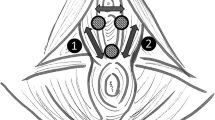Abstract
Introduction and hypothesis
To determine if Paula method of circular muscles contraction e.g., those surrounding the eyes, mouth and fingers, could increase pelvic floor muscle (PFM) activity.
Methods
Thirty-four healthy, nulliparous volunteers were included, with an average age of 28 (±5.9) years and body mass index of 23.8 (±3.3) kg/m2. They were assigned to randomly perform the sequence: a PFM maximal voluntary contraction, a contraction of circular muscles, followed by a simultaneous combination of PFM and circular muscle contraction. The PFM were evaluated using surface electromyography.
Results
PFM activity at baseline was 22.6 (±10.9) μv. It was unchanged with Paula method contraction (p = 0.322). There were also no differences between values of PFM maximal voluntary contraction alone, 99.8 (±44.3) μv and in combination with the Paula method, 91.8 (±35.3) μv (p = 0.093).
Conclusions
The Paula method seems not to increase PFM activity in nulliparous women.
Similar content being viewed by others

Abbreviations
- PFMT:
-
Pelvic floor muscle training
- PFM:
-
Pelvic floor muscles
- MVC:
-
Maximal voluntary contraction
- RCT:
-
Randomized controlled trial
- SEMG:
-
Surface electromyography
- SPSS:
-
Statistical package for social sciences
- BMI:
-
Body mass index
References
Bo K, Morkved S, Frawley H, Sherburn M (2009) Evidence for benefit of transversus abdominis training alone or in combination with pelvic floor muscle training to treat female urinary incontinence: a systematic review. Neurourol Urodyn 28(5):368–373
Hay-Smith EJC, Dumoulin C (2006) Pelvic floor muscle training versus no treatment, or inactive control treatments, for urinary incontinence in women. The cochrane database of systematic reviews, 1st issue. The cochrane collaboration. Wiley, UK
Sapsford R (2004) Rehabilitation of pelvic floor muscles utilizing trunk stabilization. Man Ther 9:3–12
Liebergall-Wischnitzer M, Hochner-Celnikier D, Lavy Y, Manor A, Paltiel O (2005) Paula method of circular muscle exercises for urinary stress incontinence—a clinical trial. Int Urogynecol J 16:345–351
Liebergall-Wischnitzer M, Hochner-Celnikier D, Lavy Y, Manor O, Shveiky D, Paltiel O (2009) Randomized trial of circular muscle versus pelvic floor training for stress urinary incontinence in women. J women’s health 18(3):377–385
Bo K (2007) Pelvic floor and exercise science: motor learning. In: Bo K, Berghmans B, Morlved S, Van Kampen M (eds) Evidence-based physical therapy for the pelvic floor. Elsevier, Amsterdam, pp 119–132
Grape HH, Dedering A, Jonasson AF (2009) Retest reliability of surface electromyography on the pelvic floor muscles. Neurourol Urodyn 28:395–399
Bo K, Ascheoug A (2007) Pelvic floor and exercise science: strength training. In: Bo K, Berghmans B, Morlved S, Van Kampen M (eds) Evidence-based physical therapy for the pelvic floor. Elsevier, Amterdam, pp 119–132
Castro RA, Arruda RM, Zanetti MRD, Santos PD, Sartori MGF, Girão MJBC (2008) Single-blind, randomized, controlled trial of pelvic floor muscle training, electrical stimulation, vaginal cones and no active treatment in the management of stress urinary incontinence. Clinics 64:465–472
American College Sports Medicine (1998) The recommended quantity and quality of exercise for developing and maintaining cardiorespiratory and muscular fitness, and flexibility in healthy adults. Med Sci Sports Exerc 30:975–991
Zanetti MRD, Castro RA, Rotta AL, Santos PD, Sartori MGF, Girão MJBC (2007) The impact of supervised physiotherapeutic pelvic floor exercises for treating female stress urinary incontinence. São Paulo Med J 125(5):265–269
Camargo FO, Rodrigues AM, Arruda RM, Sartori MGF, Girão MJBC, Castro RA (2009) Pelvic floor muscle training in female stress urinary incontinence: comparison between group training and individual treatment using PERFECT assessment scheme. Int Urogynecol J 20(12):1455–1462
Kegel A (1952) Stress incontinence and genital relaxation. Clin Simposia 4(2):35–51
Talasz H, Himmer-Perschak G, Marth E, Fischer-Colbrie J, Hoefner E, Lechleitner M (2008) Evaluation of pelvic floor muscle function in a random group of adult women in Austria. Int Urogynecol J 19:131–135
Talasz H, Gosch M, Enzelsberger H, Rhomberg HP (2005) Female geriatric patients with urinary incontinence symptoms and their control over pelvic floor muscles. Z Gerontol Geriatr 38(6):424–430
Auchincloss CC, McLean L (2009) The reliability of surface EMG recorded from the pelvic floor muscles. J Neurosci Meth 182:85–96
Vodusek DB (2002) The role of electrophysiology in the evaluation of incontinence and prolapse. Curr Opin Obstet Gynecol 14:509–514
Acknowledgment
The authors are grateful for the support received from Mahle Foundation.
Conflicts of interest
None
Author information
Authors and Affiliations
Corresponding author
Rights and permissions
About this article
Cite this article
Resende, A.P.M., Zanetti, M.R.D., Petricelli, C.D. et al. Effects of the Paula method in electromyographic activation of the pelvic floor: a comparative study. Int Urogynecol J 22, 677–680 (2011). https://doi.org/10.1007/s00192-010-1331-x
Received:
Accepted:
Published:
Issue Date:
DOI: https://doi.org/10.1007/s00192-010-1331-x



